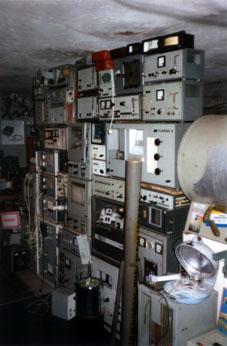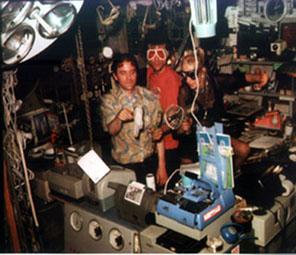The Glowing Pickle
A unique social hang-out, the Glowing Pickle was situated in a garage at Brunnenstr. 192, Berlin, and open on Thursday nights during 1993-95.
A collaboration between Laura Kikauka, Gordon Monahan, and Bastiaan Maris. It was conceived as a centre for the collection and re-distribution of DDR scientific and industrial equipment from local East Berlin dumpster containers. The name of ‘The Glowing Pickle’ comes from the action of sticking two wires into an ordinary pickle and plugging it into 220 volts. The pickle then burns and glows like a light bulb.
The Glowing Pickle salvaged many unusual pieces of equipment and documents from the former East-Bloc scientific research establishment. The equipment that still functioned was set up in the Pickle and interfaced with other equipment so that the management and public could perform hands-on experiments. Some examples of this equipment include a 1969 Czechoslovakian analog computer (the MEDA 41-TC), a Tesla 14-track tape recorder, pieces of an electronic music studio, 2 paper shredders, some ion guns, a ‘wooden computer’, several electronic counting machines and computers, Polish voltmeters, high voltage generators, mass spectrometers, a massage machine, and numerous x-y plotters. The total amount of equipment collected over the 3 year period amounted to approximately 20 tons.
The managers of The Glowing Pickle integrated the management styles of electronic surplus bargain stores prominent in post-war United States, with entertaining rituals of applied science using the available equipment. Every Thursday night at midnight, there was a ‘Midnite Madness’ auction. Several objects, such as holograms, computer boards, hand-made glass and ceramic chemistry vessels, or medical probes, were selected and auctioned in one round to the highest bidder. The winning buyer always received a free tie, shredded while-U-wear-it, in the paper shredder. The winning buyer (as well as everyone else who buys something at the Glowing Pickle) receives a free membership which entitles them to discounts on future purchases, and one Glowing Pickle Dollar (GPD) for every Deutschmark spent (for instance, for a purchase of DM 20, the consumer receives GPD 20). The consumer can then save their Glowing Pickle Dollars to buy certain items from the store, available for perusal on the ‘Glowing Pickle Dollar Shelf’. While the membership cards and Glowing Pickle Dollars function well as marketing tools, The Glowing Pickle aesthetically manipulates the purchasing process in a way that satirizes normally serious consumer procedures. In other words, prices are subject to change according to our mood.


